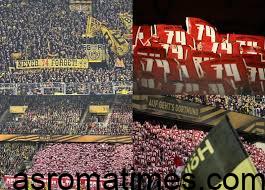Introduction: Roma, one of the most passionate football clubs in Italy, has a unique fan culture that is deeply influenced by the Ultras. The Ultras, a group of dedicated and vocal supporters, play a significant role in shaping the atmosphere and identity of the club. In this blog post, we will explore the role of the Ultras in Roma’s fan culture and their impact on the team and the stadium experience.

- History of the Ultras: The Ultras movement in Roma originated in the 1970s and quickly gained prominence. They are known for their unwavering loyalty, colorful displays, and passionate chants that reverberate throughout the Stadio Olimpico. The Ultras’ commitment to the club has made them an integral part of Roma’s fan base.
- Creating an Intimidating Atmosphere: One of the primary roles of the Ultras is to create an intimidating atmosphere for the opposition. Through synchronized chants, flares, and large banners, they turn the stadium into a cauldron of noise and energy. The Ultras’ presence inspires and motivates the players, making the Stadio Olimpico a fortress for the home team.
- Tifo Displays: Tifo displays are a visual spectacle created by the Ultras before and during matches. These displays involve choreographed movements, giant banners, and flags that showcase the team’s colors and symbols. Tifo displays not only enhance the visual appeal of the stadium but also serve as a powerful expression of unity and support for the players.
- Strong Sense of Identity: The Ultras play a crucial role in fostering a strong sense of identity among Roma fans. They embody the values and traditions of the club, often carrying historical references and symbols in their displays. Through their passion and dedication, the Ultras create a bond that unites fans from different generations, ensuring the continuity of the club’s spirit.
- Influence on Club Policies: The Ultras’ influence extends beyond the stadium. They have a strong voice in shaping club policies, ranging from ticket pricing to player transfers. Their organized protests and activism have compelled the club’s management to consider their demands and engage in dialogues with the fan base.
Conclusion: The Ultras are an integral part of Roma’s fan culture, adding vibrancy, passion, and identity to the club. Their relentless support and unwavering commitment make them a driving force behind the team’s success and create an unforgettable matchday experience. The Ultras’ role in Roma’s fan culture goes beyond football, as they foster a sense of community and belonging among fans. Their legacy will continue to shape the club’s identity for generations to come.

